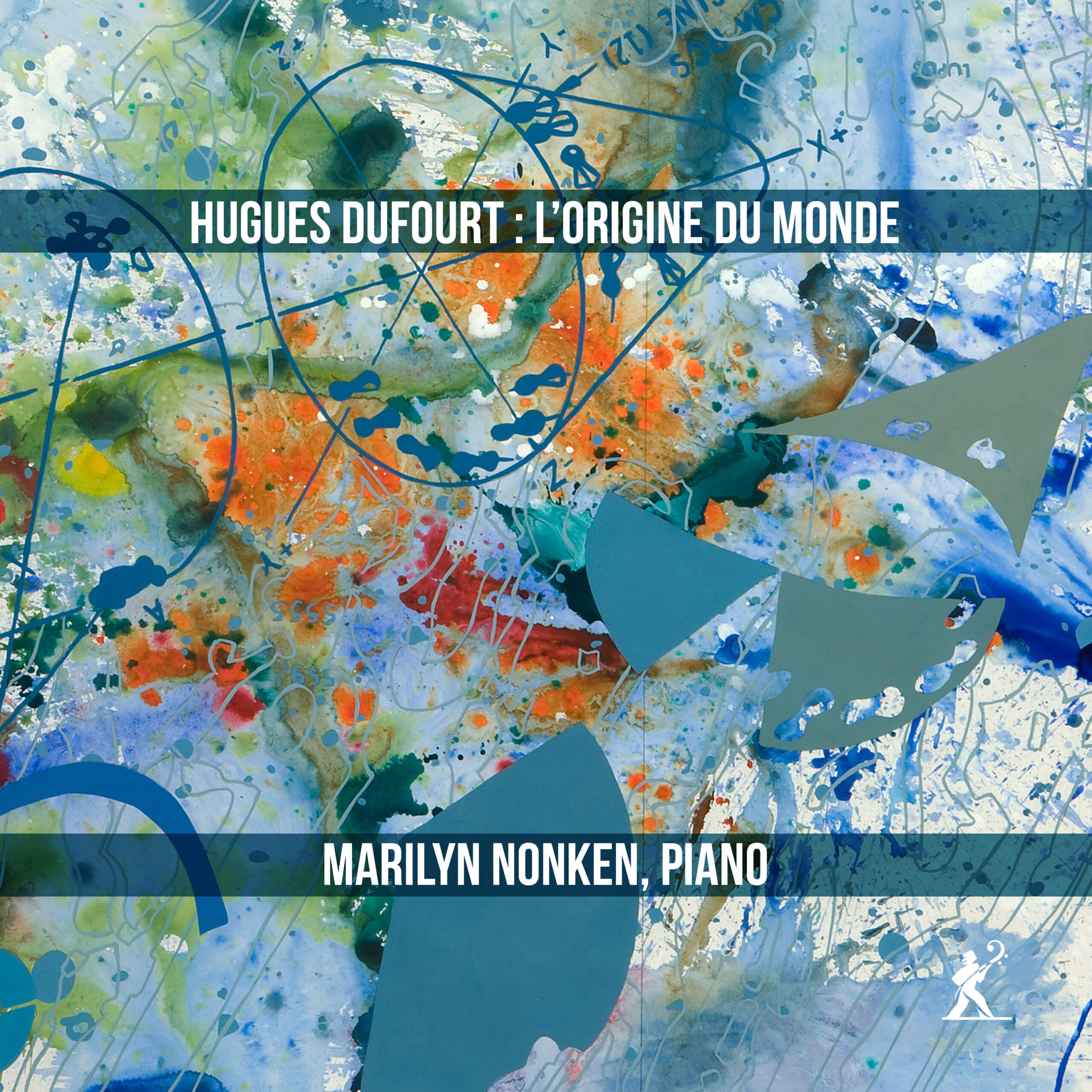The Wire
In the 20th century, musicians began exploring the inner nature of sound. Music had long spoken the language of tones – fixed, stable pitches, defined through melody, harmony and rhythm. But Western art music, through the work of Debussy, Varese, Messiaen and Stockhausen, began probing alternatives. Varèse used batteries of percussion to subvert traditional orchestral sonority, so that – as Jonathan Harvey commented – “there’s no longer a sharp division between ‘noise’ and ‘musical tone'”. By the mid-1970s, French composers Hugues Dufourt, Gérard Grisey and Tristan Murail, and Romanian composer Horatiu Rädulescu, were analysing the sound spectrum. Dufourt described their work as “musique spectrale” and the movement became known as spectralism – music that works with the harmonic spectrum.
L’Origine Du Monde – Marilyn Nonken’s third exploration of spectral piano music for Métier – is a superb release. It features The NYU Contemporary Music Ensemble conducted by Jonathan Haas, and was recorded at Troy Music Hall in Upstate New York. The venue’s blend of clarity with warmth is necessary for spectralism’s focus on harmonics. In the works assembled here, physicality of performance is inseparable from musical sensuousness.
Rädulescu described spectral techniques as “a conceptual reply… to Pythagoras”. The Greek thinker had discovered that a string’s natural harmonics divide into mathematical proportions. Thus the ratios of the first three overtones of the harmonic series became the main intervals of the musical scale, the octave, fifth and fourth. But for the spectralists, the equal temperament system of major and minor keys led composers on a false path.
Spectralists turn back to something closer to the natural harmonic series. Every note or tone is the fundamental, lowest tone, of its own harmonic series or spectrum of over tones, which – they believe – equal temperament distorts in its drive to uniformity. But they mostly extend equal temperament rather than abandoning it, using quartertone or sixthtone approximations to the ideal pure pitch (there are parallels here with how serialism treats tonality). Spectralists also work with distorted spectra and inharmonic spectra (or noise).
Like his colleagues, Dufourt analyses sound as a physical and psychological experience, and the pieces on his Métier album reflect his philosophy of “sculpting a block of sound”, to quote Tristan Murail. Thus spectralism can be defined as form of high modernism that sculpts sound, creating space gesture, timbre and nuance.
The outstanding composition is Dufourt’s ensemble piece L’Origine Du Monde (2004). It’s inspired by Gustave Courbet’s painting of 1866, which depicts the female genitalia – both painting and composition are confrontational. The uses spectral techniques to amplify the piano’s overtones, blending them with exotic, microtonally inflected percussion to create a hieratic, imperious composition. It’s a powerful construction with a wonderfully elastic tension that rises with miraculous pacing to a roiling climax.
Meeresstille (1997) is a lugubrious, almost entropic depiction of the superficial stillness of a calm sea, while Rastlose Liebe (2000) unleashes a merciless storm. In An Schwager Kronos (1994) Dufourt refers to Goethe’s portrayal of time as a coachman; the resonating piano is pushed close to distortion, yet sensitive pedalling highlights the piece’s structure. The album concludes with Tombeau De Debussy (2019), a haunting tribute to the proto-spectralist master.
Thanks to Stockhausen’s work of the 50s and 60s, spectralism is often linked with electronic composition, where frequencies can be measured precisely. But though their orchestral sounds are often electronic, Dufourt, Grisey and Murail mostly use acoustic instruments. Helmut Lachenmann’s “musique concrète instrumentale”, from a similar era, exhibits the same paradox.
Where spectral qualities are dominant, the music is often slow and static, but that’s not Dufourt’s imaginative way – this is full of Romantic Sturm und Drang. As has been said, Dufourt reveres tradition without being traditional. Like the best music (and art) based on a theory, his compositions work – and for must work – even if you don’t know the theory. Most listeners will enjoy them for their compelling sensuous qualities.
@divineartrecordingsgroup
A First Inversion Company
Registered Office:
176-178 Pontefract Road, Cudworth, Barnsley S72 8BE
+44 1226 596703
Fort Worth, TX 76110
+1.682.233.4978






![Listen to the full suite of Marcel Dupré’s Variations Sur un Noël, Op. 20 from Alexander Ffinch’s #Expectations release today! listn.fm/expectations [in bio]](https://scontent-dfw5-1.cdninstagram.com/v/t51.71878-15/588904367_2327488161082898_8709236950834211856_n.jpg?stp=dst-jpg_e35_tt6&_nc_cat=105&ccb=7-5&_nc_sid=18de74&efg=eyJlZmdfdGFnIjoiQ0xJUFMuYmVzdF9pbWFnZV91cmxnZW4uQzMifQ%3D%3D&_nc_ohc=gQOLjaATqEIQ7kNvwGQH4_R&_nc_oc=AdkSdLtCjKXOOGodOAQHcYEbqDFlZUoeI0_CN0rUKqbY1XVsLdd23HfNzZs5kEhJh59Aro_H96xdO5uLmJrILz_C&_nc_zt=23&_nc_ht=scontent-dfw5-1.cdninstagram.com&edm=ANo9K5cEAAAA&_nc_gid=vj-2p4A8H1sMpVAAg-GwRA&oh=00_AfmHPexG8z9FWP1utQgyAIiY9n9ZJflINkcCUZW-aML8ug&oe=6947916A)

![“the ‘Manteca’ Paraphrase – a rare foray into the two-piano medium but here played double-tracked – exudes a panache of which Dizzy Gillespie would surely have approved.… [a] recital well worth investigating.” —Gramophone Magazine with high praise for Ophelia Gordon's debut release, Kapustin: Between the Lines!](https://scontent-dfw5-3.cdninstagram.com/v/t51.82787-15/598796470_18303255136283342_540941604740887837_n.jpg?stp=dst-jpg_e35_tt6&_nc_cat=108&ccb=7-5&_nc_sid=18de74&efg=eyJlZmdfdGFnIjoiRkVFRC5iZXN0X2ltYWdlX3VybGdlbi5DMyJ9&_nc_ohc=sFsWUr2jc5wQ7kNvwEMM-ng&_nc_oc=AdlBBdQ-w0k9N_LidlVzzP0HEQKXhoySQHmgoh0pmkItkndYUDwNehFKAdBYnqow7uJpiTvghERieY_KYWIMx48M&_nc_zt=23&_nc_ht=scontent-dfw5-3.cdninstagram.com&edm=ANo9K5cEAAAA&_nc_gid=vj-2p4A8H1sMpVAAg-GwRA&oh=00_AflIrMgytfyJJEn6KRu1NUxBAVX7nnf5RnTDhl6Xbu0_dw&oe=6947A404)



